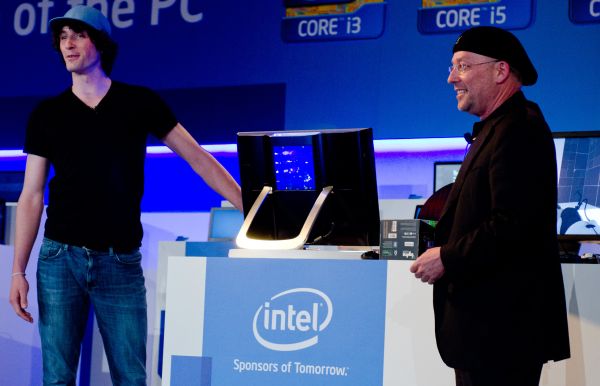Computex 2011: Intel Demonstrates Fanless 95W TDP Sandy Bridge All-in-One System
by Anand Lal Shimpi on May 31, 2011 3:54 AM EST- Posted in
- Trade Shows
- Intel
- Sandy Bridge
- Computex 2011
That's right, what you're looking at is a 95W TDP Sandy Bridge All-in-One system that is cooled only via large heatsinks and no fan. Heat rises upwards and is vented out of the top of the machine but Intel says it doesn't need a fan. Apparently Intel holds some patents on the design and is willing to share it with its partners.















8 Comments
View All Comments
davepermen - Tuesday, May 31, 2011 - link
I have a passive cooled core2duo at home as a home server. And a passive cooled media center. together with SSD, that means 100% silent systems. Which is awesome.rs2 - Tuesday, May 31, 2011 - link
Core 2 Duo for a server box that is probably sitting idle half the time (at least)? Passive cooling or no, that is wasting a ton of energy. Why not use an Atom/Brazos based box. Those things are practically designed for creating always-on, silent, low-volume, sits-idle-90%-of-the-time boxes.Shadowmaster625 - Wednesday, June 1, 2011 - link
It is probably a hand-me-down thing. It would cost more energy-money units to replace it with something that consumes only probably 20 watts less. That's only 20 bucks a year in savings. After 3 years you would save $60, but then again after 3 years there will surely be a new hand-me-down box.Mumrik - Tuesday, May 31, 2011 - link
It may be passive, but it looks huge and heavy for an IMac style design. I'd expect that to make it a hard sell to ordinary people.Spivonious - Tuesday, May 31, 2011 - link
Intel doesn't make complete systems, so I'm sure they'll license their internal design out to OEMs that have better design sense.gevorg - Tuesday, May 31, 2011 - link
What if someone would put a high load on such system for 1-2hrs (i.e. gaming, video encoding, etc). Its unlikely to sustain all that heat passively.hyvonen - Tuesday, May 31, 2011 - link
I built a passive-cooled SB HTPC/server rig for myself; in a small case (http://www.newegg.com/Product/Product.aspx?Item=N8... It works fine, but whenever I Prime or encode, it starts running this throttling cycle: whenever the CPU heat reaches 60C (!), it drops the voltage and clocks automatically to cut down the heat.In a way it's kind of smart - for short jobs and regular use, it'll run superfast with turbo and all, but anything longer and more intensive, it'll run in sort of a "max-heat-limited", "pulse-width-modulated" mode to do as much as it can within the parameters of the cooling solution. I bet if I add a slow fan on it, it would throttle far less...
That said, I find it particularly annoying that this throttle would not let the CPU heat reach 85C or something... my passive Clarkdale rig doesn't do this heavy throttling, and in Prime reaches a toasty, sustainable 88C but still runs at regular clock speeds.
Oxford Guy - Thursday, June 9, 2011 - link
Apple's Mac Plus was passively cooled. The result? When the RAM was maxed out at 4 MB, the machine would overheat.Apple also revisited fanless cooling with the Cube and certain CRT iMacs. Both had cooling issues.
Completely passive designs are generally a bad idea.